
A matrix is a structured arrangement of numbers, which can be either real or complex, organized in a rectangular grid format consisting of m horizontal lines (known as rows) and n vertical lines (known as columns). This grid is referred to as a matrix of order m by n, often denoted as an m × n matrix. The numbers within the matrix are enclosed within square brackets [ ] or parentheses ( ).
Introduction to Matrices
In a nutshell, the matrix described above can be represented by the notation A = [a ij ] mxn. Here, the individual numbers a11, a12, and so on, are referred to as the elements of the matrix A. Each element, denoted as a ij , belongs to the ith row and jth column, making it the (i, j)th element of the matrix A, which is written as A = [a ij ].
Important Formulas for Matrices
If A and B are square matrices of order n, and In is a corresponding unit matrix, then
- A(adj.A) = | A | In = (adj A) A
- | adj A | = |A| n-1 (Thus A (adj A) is always a scalar matrix)
- adj (adj.A) = | A | n-2 A
- adj (AB) = (adj B) (adj A)
- adj (Am) = (adj A)m,
- adj 0 = 0
- A is symmetric ⇒ adj A is also symmetric
- A is diagonal ⇒ adj A is also diagonal
- A is triangular ⇒ adj A is also triangular
- A is singular ⇒| adj A | = 0
Types of Matrices
(i) Symmetric matrix: A square matrix A = [a ij ] is called a symmetric matrix if a ij = a ji , for all i, j.
(ii) Skew-symmetric matrix: when a ij = – a ji
(iii) Hermitian and skew–Hermitian matrix:
(iv) Orthogonal matrix: if AAT = In = ATA
(v) Idempotent matrix: if A2 = A
(vi) Involuntary matrix: if A2 = I or A-1 = A
(vii) Nilpotent matrix: A square matrix A is nilpotent; if Ap = 0, p is an integer.
Trace of Matrix
The trace of a square matrix is the sum of the elements on the main diagonal.
(i) tr(λA_ = λ tr(A)
(ii) tr(A + B) = tr(A) + tr(B)
(iii) tr(AB) = tr(BA)
Also Check – Comparing Quantities Formula
Matrix Transpose
- (AT)T= A
- (A+B)T= AT + BT
- (AB)T= BTAT
- (kA) T = k(A) T
- (A1A2A3…..An-1An) T = A T n A t n-1 …..A T 3 A T 2 A T 1
- I T = I
- tr(A) = t(A T )
Properties of Matrix Multiplication
- AB ≠ BA
- (AB)C = A(BC)
- A (B + C) = AB + AC
- (A + B)C = AC + BC
Adjoint of a Matrix
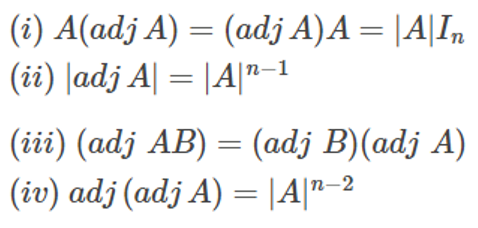
Also Check – Congruence of Triangles
Inverse of a Matrix
A-1 exists if A is non-singular, i.e.,
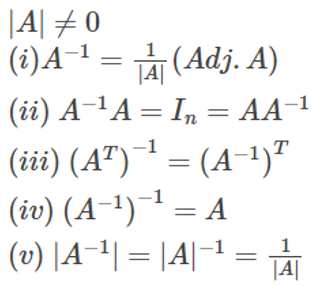
Order of a Matrix
A matrix with m rows and n columns is designated as a matrix of order m x n.
For instance, consider the following matrix:
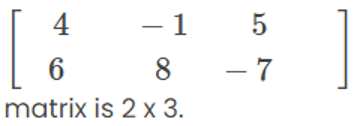
Please note the following:
(a) A matrix is simply a structured arrangement of specific quantities.
(b) The elements within a matrix can consist of real or complex numbers. If all the elements in a matrix are real numbers, it is referred to as a real matrix.
(c) An m x n matrix contains a total of m * n elements.
Illustration 1: Create a 3×4 matrix A = [aij] with elements defined as a ij = 2i + 3j.
In this illustration, we will build a 3×4 matrix denoted as A, where each element a ij is determined using the formula aij = 2i + 3j.
Solution: In this particular problem, we have 'i' representing the number of rows, and 'j' representing the number of columns. By substituting the appropriate values for rows and columns into the formula a ij = 2i + 3j, we can construct the desired matrix.
Using the formula a ij = 2i + 3j:
For the 3×4 matrix A, we can compute its elements as follows:
a11 = 2(1) + 3(1) = 5
a12 = 2(1) + 3(2) = 8
a13 = 2(1) + 3(3) = 11
a14 = 2(1) + 3(4) = 14
a21 = 2(2) + 3(1) = 7
a22 = 2(2) + 3(2) = 10
a23 = 2(2) + 3(3) = 13
a24 = 2(2) + 3(4) = 16
a31 = 2(3) + 3(1) = 9
a32 = 2(3) + 3(2) = 12
a33 = 2(3) + 3(3) = 15
a34 = 2(3) + 3(4) = 18
Using these calculations, we can construct the 3×4 matrix A with the respective values for its elements.
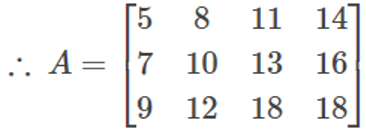
Also Check – Cubes and Cubes Roots Formula
Trace of a Matrix
Let A = [aij]nxn and B = [bij]nxn and λ be a scalar,
(i) tr(λA) = λ tr(A)
(ii) tr(A + B) = tr(A) + tr(B)
(iii) tr(AB) = tr(BA)
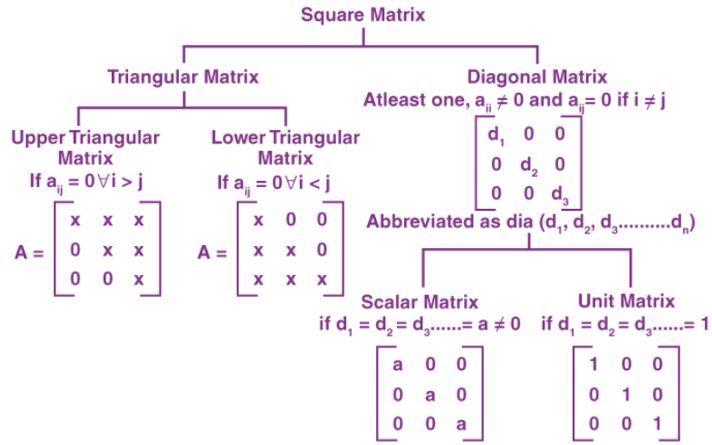
Transpose of Matrix
The transformation of a given matrix A by interchanging its rows and columns results in a new matrix known as the transpose of matrix A, denoted by AT or A'. According to this definition, if the original matrix A has an order of m x n, then the order of its transpose, AT, becomes n x m.
For instance, consider the transpose of a matrix:

Also Check – Factorization Formula
Properties of Transpose of Matrix
- (AT)T= A
- (ii) (A + B)T = AT+ BT
- (iii) (AB)T = BTAT
- (iv) (kA)T = k(A)T
- IT = I
- (vii) tr(A) = tr(AT)
Matrices Formula FAQs
Q1. What is a null matrix?
Q2. What is the transpose of a matrix?
Q3. What is a diagonal matrix?
Q4. What is a square matrix?
Q5. Provide the formula for finding the inverse of a matrix A.










